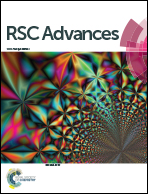Preparation and characterization of foamy poly(γ-benzyl-l-glutamate-co-l-phenylalanine)/bioglass composite scaffolds for bone tissue engineering
Abstract
In this study, novel foamy scaffolds of poly(γ-benzyl-L-glutamate) (PBLG) and poly(γ-benzyl-L-glutamate-co-L-phenylalanine) (P(BLG-PA)) were fabricated via a combination of a sintered NaCl templating method and ring-opening polymerization of α-amino acid N-carboxyanhydrides. The obtained polypeptide-based scaffolds displayed a foamy structure and had a desirable glass transmission temperature (23.2–44.6 °C), contact angle (78.5–88.5°), compression modulus (56.3–110.2 kPa) and degradation time (>8 weeks). MC3T3-E1 cells were used to test the in vitro biocompatibility, and we found that PBLG scaffolds could significantly promote cell viability and proliferation compared to P(BLG-PA) scaffolds. In addition, micro-scale bioglass particles (BG) were incorporated into PBLG to form a porous scaffold, namely PBLG/BG composite scaffolds, which further enhanced the cell viability and adhesion, as confirmed by live-dead staining and SEM observation. The results of the ALP activity assay suggested that PBLG/BG composite scaffolds could promote the osteogenic differentiation of MC3T3-E1 cells. The results of histology analysis showed that the PBLG/BG composite scaffolds rather than PBLG scaffolds significantly promoted connective tissue and vascular ingrowth. The results obtained using digital radiography technology showed that PBLG/BG composite scaffolds significantly improved osteogenesis in vivo. In summary, our results indicated that PBLG/BG composite scaffolds could be a promising bioactive substance for bone regeneration.


 Please wait while we load your content...
Please wait while we load your content...